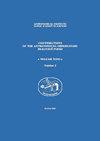近食双星BD和:一个三重系统
IF 0.2
4区 物理与天体物理
Q4 ASTRONOMY & ASTROPHYSICS
Contributions of the Astronomical Observatory Skalnate Pleso
Pub Date : 2020-05-15
DOI:10.31577/CAOSP.2020.50.3.649
引用次数: 0
摘要
BD和是一个相当明亮(V=10.8)、活跃且接近(P=0.9258天)的食双星。视轨道周期的循环变化以及光曲线中的第三光表明存在额外的晚期成分。主要目的是对第三体假说进行光谱测试,并确定食双星两个分量的绝对恒星参数。获得了该系统的第一个中分辨率光谱。使用了适用于紧密双星的重加宽光谱的加宽函数技术。径向速度是通过拟合高斯函数和旋转轮廓来确定的。还获得了有限数量的光度数据。尽管光度观测的重点是获得时间信息,但也进行了粗略的光曲线分析。提取的增宽函数清楚地显示了第三种缓慢旋转的成分的存在。它的径向速度在食对的系统速度的误差范围内,有力地支持了物理键。观测到的系统径向速度和第三分量的变化不支持从时间变化中发现的9年轨道。食对的分量的质量以大约0.5%的精度确定。该系统的进一步表征将需要长期的光度和光谱监测。本文章由计算机程序翻译,如有差异,请以英文原文为准。
Close eclipsing binary BD And: a triple system
BD And is a fairly bright (V = 10.8), active and close (P = 0.9258 days) eclipsing binary. The cyclic variability of the apparent orbital period as well as third light in the light curves indicate the presence of an additional late-type component. The principal aim is the spectroscopic testing of the third-body hypothesis and determination of absolute stellar parameters for both components of the eclipsing binary. First medium and high-resolution spectroscopy of the system was obtained. The broadening-function technique appropriate for heavily-broadened spectra of close binaries was used. The radial velocities were determined fitting the Gaussian functions and rotational profiles to the broadening functions. A limited amount of photometric data has also been obtained. Although the photometric observations were focused on the obtaining the timing information, a cursory light-curve analysis was also performed. Extracted broadening functions clearly show the presence of a third, slowly-rotating component. Its radial velocity is within error of the systemic velocity of the eclipsing pair, strongly supporting the physical bond. The observed systemic radial-velocity and third-component changes do not support the 9 year orbit found from the timing variability. Masses of the components of the eclipsing pair are determined with about 0.5% precision. Further characterization of the system would require long-term photometric and spectroscopic monitoring.
求助全文
通过发布文献求助,成功后即可免费获取论文全文。
去求助
来源期刊
CiteScore
1.10
自引率
20.00%
发文量
4
审稿时长
>12 weeks
期刊介绍:
Contributions of the Astronomical Observatory Skalnate Pleso" (CAOSP) is published by the Astronomical Institute of the Slovak Academy of Sciences (SAS). The journal publishes new results of astronomical and astrophysical research, preferentially covering the fields of Interplanetary Matter, Stellar Astrophysics and Solar Physics. We publish regular papers, expert comments and review contributions.

 求助内容:
求助内容: 应助结果提醒方式:
应助结果提醒方式:


